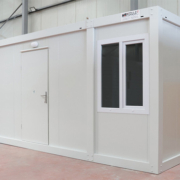Datum PhaseChange Ltd an award winning manufacturer of Phase Change Ceiling tiles for Schools and Hospitals have been manufacturing ThermaCool® ceiling and wall tiles since 2008. Helping reduce the energy demand of HVACs and adding thermal mass to lightweight buildings.
PCMs Explained
PCMs (phase change materials) are materials that undergo a phase change transition from solid to liquid and liquid to solid to absorb or release large amounts of latent heat at a relatively constant.
Reduce Energy Demand
Essentially, PCMs work in the same way as a material with thermal mass – capturing and releasing energy to smooth out peaks and troughs of the heating and cooling cycle. By removing these peaks and troughs, often as a result of air conditioning systems, phase change materials manage the internal temperatures more effectively and efficiently to provide a comfortable working temperature throughout the day.
Increasing thermal mass Phase Change Materials are a lightweight solution for thermal mass that can be up to 9 x lighter than heavy density concrete.
A comfortable working temperature PCMs smooth out temperature peaks of a building resulting in an improved working environment.
ThermaCool® Innovation
Through this natural process of phase change, we have used the technology in our ThermaCool® wall and ceiling products, giving both thermal mass to lightweight structures and also significantly reducing the energy demand of climate control systems.
For use in both new build construction and retrofit of commercial and residential buildings, our ThermaCool® products reduce the energy consumption of climate control systems. Our products offer competitively priced, easy to install solutions that yield significant energy and carbon savings for your building.
Thermal Mass Explained
A thermal mass is a material that absorbs heat from a heat source, and then releases it slowly. In buildings, thermal mass is provided by the structure of the building.
Buildings constructed of lightweight materials such as steel or timber are not considered to have good thermal mass properties compared to concrete, brick and stone.
The ability to absorb and release heat enables buildings with thermal mass to respond naturally to changing weather conditions, helping to stabilise the internal temperature.
Benefit throughout the year
The role of a buildings thermal mass can be of benefit throughout the year. During the warm weather in summer, heat will be absorbed by the thermal mass in order to prevent overheating in the building, providing a more comfortable living or working environment. During the winter, when heating demands are at their greatest, thermal mass can help reduce fuel consumption by absorbing heat produced from occupants, lighting and IT during the day and then slowly releasing them overnight as temperatures fall, reducing the need for additional heating the following day.
Reduce your emissions
18% of UK’s CO2 emissions come from public and commercial buildings. Our ThermaCool® products drastically reduce the demand for energy, can be widely introduced, enabling the greatest reduction in CO2 emissions per pound spent. Our ThermaCool tiles incorporate our microencapsulated phase change material when installed as either as replacement for existing tiles in a retrofit project or as a complete system for newbuild construction they provide a cost effective and lightweight thermal mass solution.
ThermaCool Tile – It is what’s on the inside that counts
In buildings where the thermal mass benefits from the building fabric is lost due to improved insulation and airtightness measures, or in steel or timber structures which have little or no thermal mass performance, the ThermaCool® tile offers an easy to install, cost effective and lightweight thermal mass solution.
Four tiles. Four unique benifits
ThermaCool® tiles are available either as a perforated acoustic tile, a solid tile with a light textured finish, glass wool/gypsum composite or metal plain or perforated tile.
Preformed plain or perforated gypsum tile
Is a preformed tile manufactured from recycled gypsum. Light textured or perforated Class D absorption.
Acoustic medical hygenic
Is a square edge or tegular tile installed in our Clic In modular grid 24mm/15mm. Suitable for dry areas where disinfection and cleaning is resistant to mould and bacteria growth and to common detergents and disinfectants.
A glass wool/gypsum composite tile. Hygienic for Hospitals and Health centres tile for a 600x600mm module, fitted with a suspended T-grid for easy installation.
Caprice acoustic
ThermaCool® Caprice is a class A acoustic tile light textured square or tegular edge, installed in our Clic in modular grid 24mm/15mm.Simple elegant appearance with excellent acoustic performance perfect for classrooms, meeting rooms, and conference areas.
A composite glass wool/gypsum acoustic tile for Schools. a 600x600m module, with improved acoustic performance class A sound absorption.
Metal composite
A composite tile where increased thermal and acoustic performance and aesthetic finish is required.
Metal ceiling tile plain or perforated ThermaCool® ceiling tiles are installed into a conventional suspended ceiling system like our ThermaCool® Clic In 24mm/15mm grid.
Suspended Ceiling Integration
ThermaCool® ceiling tiles are installed into a conventional suspended ceiling system like our ThermaCool Clic In 24mm grid, heat from people, lighting, small power items etc is absorbed and stored by the tiles over a defined temperature that is within the human comfort range. This heat is later released as the room temperature cools, giving the building lightweight thermal mass.






 Advanced Features for Unmatched Performance
Advanced Features for Unmatched Performance With unmatched manoeuvrability and faster operational speed, the Self-Propelled Inloader transforms yard-based logistics by eliminating the reliance on multiple trailers and shunters, significantly enhancing efficiency and reducing operational costs for businesses handling oversized, high loads.
With unmatched manoeuvrability and faster operational speed, the Self-Propelled Inloader transforms yard-based logistics by eliminating the reliance on multiple trailers and shunters, significantly enhancing efficiency and reducing operational costs for businesses handling oversized, high loads.







